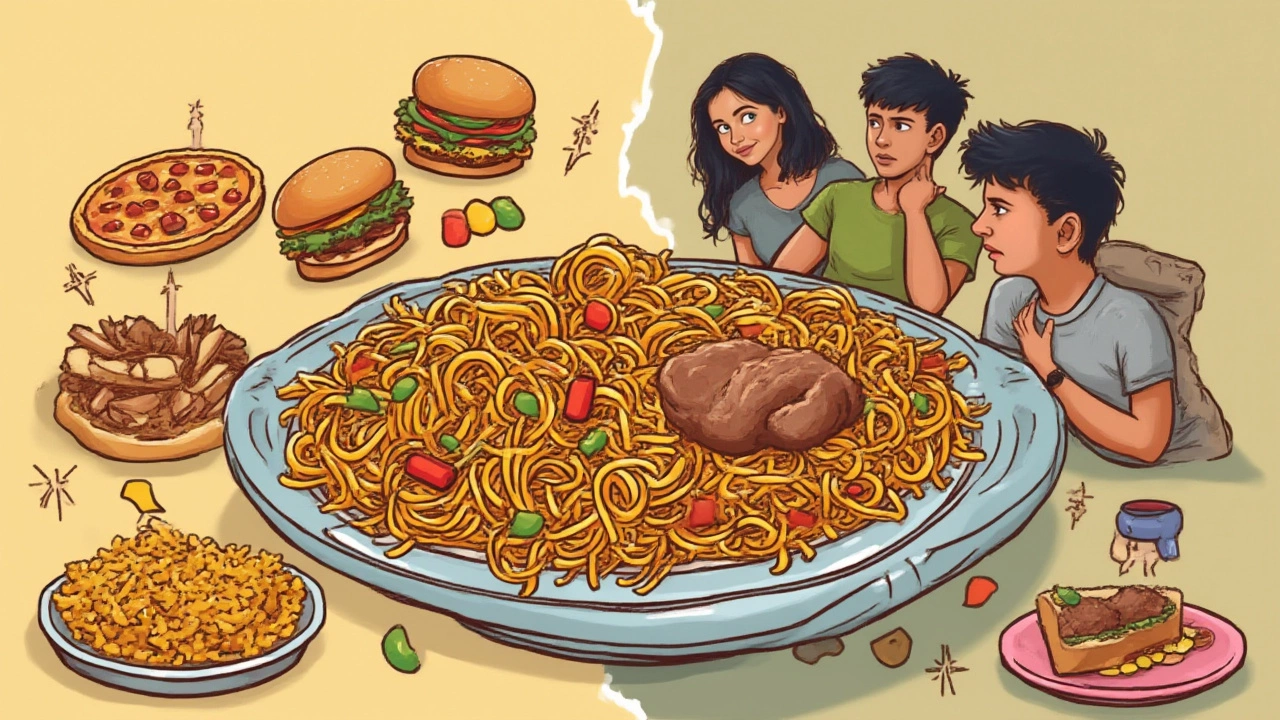Is Biryani Junk Food? Nutrition, Myths, and Surprising Facts
 Jul, 3 2025
Jul, 3 2025
The “junk food” label gets thrown around a lot, sometimes too loosely. Walk past any Indian, Pakistani, or Middle Eastern restaurant and you’ll smell the aromatic riot that is biryani—rice, meat, spices, all mingling together. But can this fabulous dish really sit beside fries or instant noodles in the ‘junk’ corner? Or are we missing something?
What Makes Food ‘Junk’? Rethinking the Biryani Debate
We all know the usual suspects—sugary sodas, chips, overly processed snacks—but what actually puts food in the “junk” basket? Nutritionists usually look at a few things: little nutritional value, loads of unhealthy fats, excessive salt and sugar, and not much in the way of vitamins, fiber, or protein. Now, biryani can be calorie-dense, sure. But when you look closer, things get less black-and-white.
Biryani is a celebration dish for a reason—it’s got layers, literally. Let’s break it down.
- Rice is the base, usually basmati, which scores well on the glycemic index compared to many other white rices.
- Proteins come in the form of chicken, mutton, fish, or sometimes eggs or paneer.
- A symphony of spices: turmeric, cinnamon, cardamom, cloves, and more. Many of them carry anti-inflammatory and gut-friendly properties.
- Yogurt, used in marinades, brings probiotics along for the ride.
- Fresh herbs, vegetables, nuts, and raisins sometimes tag along.
Here’s a stat that might surprise you: a standard restaurant plate of mutton biryani can range from 700 to 1200 calories, mostly because of the fat and rice content. But calories alone don’t tell the whole health story—quality of ingredients and cooking method matter a lot. For example, if the biryani arrives swimming in visible oil, or if it’s made with fatty cuts of meat and barely-there veggies, you might want to keep that a rare treat.
The big takeaway? Junk food isn’t just about calories or fat—it’s about nutritional emptiness. And no, biryani isn’t void of nutrients. Let’s see what nutrition science says about the usual way biryani is made and eaten.

Biryani Nutrition Facts: The Not-So-Guilty Pleasure
Time for some myth-busting. Biryani is not a single recipe—it’s a massive family with dozens of regional cousins. Hyderabadi biryani, Kolkata biryani, Lucknowi biryani, Kerala biryani, Pakistani biryani—each has its quirks. For example, Kolkata biryani uses less oil and sometimes includes potatoes, which add fiber and potassium. Kerala biryani might swap in banana leaves for steaming and throw in more vegetables. So, what you’re eating is rarely just “biryani”—it’s someone’s unique spin.
Here’s a quick look at what’s actually in a typical homemade chicken biryani, compared to some foods known as typical junk:
| Food (1 serving) | Calories | Protein (g) | Fat (g) | Sugar (g) | Fiber (g) | Sodium (mg) |
|---|---|---|---|---|---|---|
| Chicken Biryani (350g) | 540 | 27 | 18 | 3 | 3 | 850 |
| Fast-Food Burger | 530 | 18 | 28 | 9 | 2 | 1000 |
| Packaged Noodles | 380 | 8 | 16 | 6 | 1 | 1200 |
See the differences? Biryani’s protein and fiber numbers look much less junky, especially if homemade and portion-controlled. Now, be honest—how often do you eat biryani compared to chips or pastries? The problem sneaks in when we super-size our servings, drown it in sides (raita, fried onions, etc.), and don’t balance it with movement or veggies.
Another thing to watch: some restaurants spike biryani with food colors, unnecessary preservatives, or cook with reheated oil, which can mess with its healthiness. If you cook at home, you control the salt, oil, and meat quality. Pro tip: swap white rice for half brown or even millet, reduce the oil to just enough to coat the pot, and add more veggies to tilt the dish even further away from ‘junk’ zone.
Biryani nutrition experts from Indian Dietetic Association often say homemade biryani can be a “complete meal.” It ticks the boxes for carbs, protein, complex spice antioxidants, and even healthy fats if you use moderate ghee or vegetable oil. Portion size is your real frenemy here, not the biryani itself. If you stick to a regular bowl (about 200-250 grams), instead of that party-sized heap, you’re probably safe even if you have it once a week.
Want to skip the guilt? Here are some tips:
- Add lentils (dal) or chickpeas for an extra protein and fiber boost.
- Use lean meats (remove visible fat from chicken or opt for fish/prawn).
- Reduce oil by sautéing onions with a splash of water instead of deep frying.
- Toss in green peas, carrots, beans, or capsicum.
- Halve the rice, double the vegetables, and watch how filling it still feels.
- Go easy on the salt and look for low-sodium spice blends.
Biryani wasn’t built to be mindless fast food. If you slow down and savor it, be mindful of what and how much you’re piling onto your plate, you can have your biryani and eat it too. And let’s not forget the feel-good effect—a happy, celebratory meal can do wonders for mental wellbeing. Is that something you get from a dusty snack vending machine?

Biryani Culture, Occasional Indulgence, and Hack Your Way to Healthier Plates
Biryani is bigger than just a dish—it’s part of daily life, ritual, and big celebrations in South Asia and beyond. It’s shared at family tables, during Eid, on Fridays, or just when people want something comforting at the end of a chaotic week. That sense of tradition can make people overlook what’s actually going into the pot. So it’s easy to see why some folks suspect it’s a ‘junk food’ —you eat it at festivals, weddings, late-night parties. The context makes it feel guilty, not the actual food.
Modern life doesn’t help much either. People sit more, move less, and portions have grown over the decades. If biryani is your daily meal from a canteen where quality control slips and nobody cares how much ghee is in the pot, you might want to reconsider. For most people, though, biryani is an occasional treat, not a drive-thru lunch.
Home cooks are starting to get smarter about adapting tradition to fit healthier goals. Some switch half their rice for cauliflower rice when they want low-carb biryani. Others bake or slow steam the biryani, to use less oil and lock in more nutrients. Yogurt can replace cream in marinades, and plant-based proteins like tofu can join the party for vegetarians. There are even biryanis popping up that use quinoa or broken wheat—pretty wild, but surprisingly tasty.
The best way to stop biryani from crossing over into ‘junk food’ territory is to get a grip on what goes in. Here are some quick hacks that work even for stubborn, time-strapped cooks:
- Make biryani on weekends or festival days, not every night.
- Eat slowly—studies show we register fullness in about 15-20 minutes, so savor every forkful.
- Pair a smaller serving with a big side of salad, raita with cucumber, or roasted veggies.
- Ditch the fried accompaniments like papad or deep-fried potatoes—baked is the way to go.
- If you eat out, ask how much oil they use, or go for a ‘light’ version if it’s offered. Don’t be shy to request tweaks.
- Remember that next-day biryani, reheated, still tastes awesome—just keep portions in check!
Still, biryani deserves its reputation as a dish that brings people together. It just doesn’t deserve to be tossed in with processed junk. If you respect portion control and bring fresh ingredients to the mix, it can be part of a balanced lifestyle, not a villain on your plate. Just don’t eat a kilogram by yourself while binge-watching your favorite show—we all know how tempting that is.
So, is biryani “junk food”? Not if you treat it like a celebration—something special to enjoy mindfully, cooked with real ingredients, and eaten in reasonable amounts. The problem isn’t the biryani. It’s how much, how often, and what else you’re doing. Let’s be real—you’re probably better off with homemade biryani and a walk afterward than many of the so-called convenience snacks out there. Happy eating!